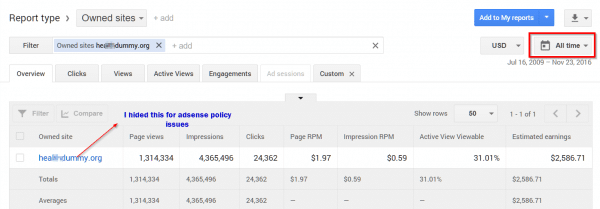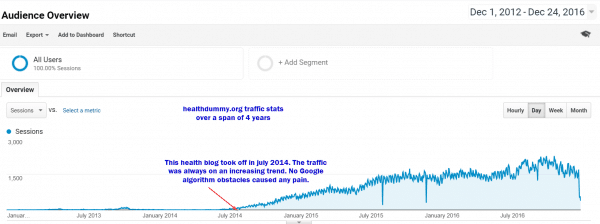The 4 key points to any SEO success are keyword research, backlinks, quality content and site layout.
[wps_note size=”17″ background=”#eeee22″ color=”#333333″ radius=”3″] In 2019, new SEO factors like topic research, mobile-first indexing, AMP, quality based content, local and personalized search will make much noise among the blogger community. But what is the ROI? (Return-of-Investment) [/wps_note]
You spend $1000 on SEO tools like ahrefs.com, SEMrush, Moz.com and $1000 more on content writers, but in return you get $100, where is the profit?
More Related :
- Keyword Research Using SEMrush – 3 Intuitive Ways To Improve On-Page SEO
- 10 Steps to Increase Website Traffic using SEMRush and Competitor Data?
- 6+ Amazing Techniques to Build Links Naturally in 2016 [Free]
So, in my journey of 8 years of blogging I spent several ‘headache’ hours finding out which is the best way to improve traffic and at the same time bring me good money.
Believe me, it is not that easy to fight a lone battle!
It’s like creating a box-office movie hit in the first-go itself.
You don’t have any friends like in an SEO agency to review your ideas or give suggestions.
The only thing you have in your hands are some GRAPHS, TOOLS and your BRAIN. Of course, you have your dearest friend Google.
[wps_note size=”17″ background=”#eeee22″ color=”#333333″ radius=”3″]But finding out which works for your blog and which doesn’t is very difficult task to realize on your own. The one thing you pray in these circumstances is LUCK. Yes, I should say I did my SEO homework and was lucky to say when I earned around $2738 in 4 years from 40 posts. Actually, it was only 3 years. The last year I didn’t work actually. [/wps_note]
So, these are the 13 SEO factors that influenced my AdSense earnings in my opinion. (Whew, I could be wrong!)
[wps_lists icon=”arrow-right” icon_color=”#81d742″]
- Niche
- Keyword Research
- Attribution to Sources
- Slug keywords
- SEO Title
- Lengthy Content
- Table of Contents
- Sub-Section.
- Full Width Blog Layout.
- Page Load Speed
- Social Media Promotion
- AdSense Ads of Right Size and in Right Position
- User Interaction and Comments
[/wps_lists]
When I started this blog, I didn’t have any idea on how much I am going to earn. But based on SEO literature from popular SEM blogs, I started with a framework.
Niche
I chose the health niche for my blog.
This is because I was already a patient and researched some websites about my condition.
So, I had gathered some information on one particular problem.
So, I concentrated on particular condition called “gastric problems”. I did not do any research to find this base keyword. It just struck in my mind based upon my experiences.
Keyword Research
The next point I decided to do was I tried to find out, what are the common words based on this base keyword that most people would like to search in Google and Bing.
It appeared to me that causes, symptoms, diagnosis, natural remedies are the common keywords searched for this particular condition.
This blog was started in 2012. So, the SEO condition was different then.
I used different tools like Google Keyword Planner and UberSuggest to find keyword suggestions.
But instead of stuffing my content with keywords, I tried to write content naturally.
More Related:
- The Best Keyword Research Tips in 2015 (For Beginners and Bloggers)?
- How To Sort Keyword Data from Keyword Planner in Excel ?
- Keyword Analysis using SEMrush, GA and GKP
Attribution to Sources
Since I was neither a doctor nor an expert in this medical field, I had to find content from reputable sources.
So, I decided to take 5 to 10 articles based upon Google research and find content which is unique to each article.
Instead of copy and pasting the same content which would have caused duplicate content issues, I made the headlines as the key points for my articles.
For example, this article with the title
“40 Natural Remedies for Gastric Problems for Instant Relief”
I took each remedy from different posts and listed them as a list.
So, it was smart to do this way.
As anybody could find the 40 natural remedies in just a few seconds.
If you observed big sites like webmd.com, everydayhealth.com etc, you see that there is lot of technical jargon involved.
But if you go through the articles, you will find that they are more or less accurate and good information.
So, I cited reputable sources, whenever I took points from such sites. I basically did outbound linking to these good resources.
Slug Keywords
The next important thing I did was I made sure to include the keyword that I was targeting in the slug of the article url.
- http://www.healthdummy.org/24/symptoms-of-gastric-problems.html
- http://www.healthdummy.org/7/causes-of-gastric-problems.html
- http://www.healthdummy.org/341/gas-pain-home-remedy.html
[wps_note size=”17″ background=”#dd9933″ color=”#333333″ radius=”3″]From my experience, later I found that, many of the websites in health niche are writing content from purely technical point of view, but not concentrating much on slug keyword research.[/wps_note]
(Well that’s my find, you can debate it!). So I included targeting keywords in the slug.
SEO Title
Next I made sure that the keyword I was targeting also appeared in the main headline or title of the article, i.e in between the H1 tag.
Then another intuitive SEO step I took was I included that keyword in the content.
Initially I had no response for such articles for 1 and ½ years. The daily traffic for the site was less than 10 sessions per day.
I thought this could be another SEO disaster.
The same strategy was tried on another blog and it failed. I was afraid this could follow in the same lines.
Lengthy Content
In my SEO reading I found that, content greater than 500 to 800 words could rank well in search engines.
In 2012 and 2013 this was the latest trend.
So, I started writing all my articles which are not less than 800 to 1000 words.
This was also meeting the justified criteria of the then SEO trend that lengthier content ranked well in Google search engine.
Table of Contents
I found a good WordPress plugin called “Table of Contents Plus” which from my experimentation found out that it produced good results from SEO point of view.
It also had a decent look in the article and also the search engines were showing results for sub-heading mentioned in this table-of-contents.
This was a positive find from SEO point of view.
A less attracted user or visitor having less span attention, need not wait for the whole article to read.
He could just go to the point he needed and just escape out of the article.
No waste of time.
But this would reduce the bounce rate.
This risk was to be taken.
Sub-Section
I divided all my articles in this health niche blog into sub-sections of H2, H3, H4 etc headings.
This made sure that the user need not get blinded by the amount of huge content present in the context.
It was made easy that he could find that solution to the problem in short paragraphs which was easy to read.
Full-Width Blog Layout
I used the Thesis framework with the main content on the left and sidebar on the right.
I also tried some other WordPress themes with 1 to 2 sidebars. But more the number of sidebars, you would also be inclined to use more links and content in it.
This caused the SEO juice to disperse to these pages.
Also, I made sure that I removed the footer which was of not much use to me. I just concentrated on the health content which would give a solution to the user’s query.
Finally, I found that having a full-width main content layout would make the reader easier to read the lines. This was good for desktop.
I also made sure that the Classic Skin of Thesis framework, is also mobile responsive.
By default, the mobile version also looked good and great.
Page Load Speed
In 2013 and 2014, Google made it clear that page load speed is going to be one of the important ranking factors.
Already I trimmed the unnecessary scripts and parts, which are a resource hog during page load time.
Then I made a smart decision of installing a plugin called W3TC. But I’m now using SiteGround hosting.
They have their own caching plugin free of cost. So you need not install any other cache plugin. The SG Optimizer plugin is just sufficient for all your caching needs.
This was a cache plugin and made sure that static resources like CSS, HTML and JS files were cached during first visit and reduced the amount of load on the server. This dramatically influenced the page loading time.
Thus, I made sure that page load times from US servers were under 1 or 2 minutes.
Social Media Promotion
From the starting of this blog, I made sure that I posted my articles to related Facebook groups and Google+ communities.
For every new group or community, I wrote a unique summary of the article, which is catchy and simple.
I am still not sure whether this helped in making my blog success or not. But in the initial stages I concentrated mostly on social media strategies and blog commenting.
This was the only off-site SEO I did apart from content writing.
No spammy linking building techniques and buying stuff from bad resources.
Adsense Ads
Now comes the key part of the earnings. This section could take a whole post to explain. But I will explain in a summary.
In the initial stages I was not sure where to position these ads or what size of ads are correct for good income.
So, I had to experiment a little. But later, with the help of my friend I found that 336×280, 160×600 ads were giving good CPC and CPM.
Also I made sure that I blocked unnecessary websites and categories in Adsense that produced less income.
I also made sure that these were placed to the top of the content.
Comments from Users
One of the key factors for the success of this blog was the user interaction I had from the health niche audience.
Every day I had at least 1 to 3 comments, asking me solutions about their gastric related queries.
I tried to find solutions in a honest way from Google research and provide answers with whatever knowledge I had.
I think this played a major role in the key success and earnings of the blog.
Conclusion
In the end, I sold this blog for $5800.
So, that is an additional asset if you have good earning blog like this one.
When I sold this blog, it was earning like $180 to $200 per month.
It is quite an asset to have such traffic increasing and income generating blogs like these, as many buyer were interested in buying this blog.
Most of the traffic to this blog was mobile. The main countries that attributed traffic to this blog were India, United States, United Kingdom and Canada.
In the end, writing quality content in health niche and doing proper SEO, could reap good benefits in 2019.
This is unlike Tech or Entertainment niche, as this was more flooded by competition.
I hope I have given a decent bird’s-in-depth-review of my SEO analysis of this blog on how I earned around $8000 from this blog.
Let me know your views and comments on this article and share this article if you like.!!!









Nice writing article, it is still relevant till now……
Thanks , it means more to me
You wrote only 40 article ( post ) in 4 years? It is realy unbeliable.